Sustainable exploration and production of oil and natural gas involves a commitment to clean air quality through the design and operation of facilities that meet or exceed federal or provincial air quality objectives.
Air emissions data is typically presented in two distinct ways, volume and intensity. Volume is important as it provides information regarding overall trends in total emissions. It is impacted by many factors and does not provide a perspective on efficiency of operations. Intensity measures are important in understanding how efficient an operation is in terms of the emissions associated with delivering each unit of production. While both absolute and intensity measures provide important information to the oil and natural gas industry intensity is the more relevant measure of operational performance. It normalizes, or accounts for, changes in product, production volumes and mix and it allows oil and natural gas companies to evaluate their own operations and against their competitors – both domestic and international.
Greenhouse Gases
The oil and gas industry is focused on reducing greenhouse gas (GHG) emissions intensity. Industry recognizes that as production grows, ongoing investment in innovation and technology will be needed to reduce the amount of GHG emitted for each barrel of oil or thousand cubic feet of natural gas produced. Technology and innovation will continue to be critical tools for reducing emissions intensity as production of conventional and unconventional oil and gas resources continues to grow across Canada.
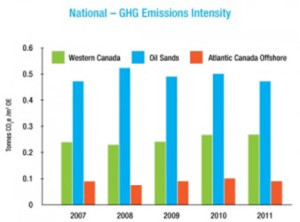
Regional GHG intensities are generally holding flat or declining. Source: Canadian Association of Petroleum Producers.
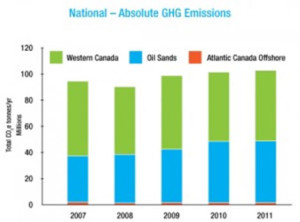
Total GHG emissions for the sector remained flat while there was a one per cent growth in oil and natural gas production in 2011. Source: Canadian Association of Petroleum Producers.
Direct GHG emissions from Canada’s oil and natural gas industry declined 0.5 per cent from 88.1 million tonnes in 2010, to 87.6 million tonnes in 2011. Indirect emissions increased slightly from 14.3 million tonnes in 2010 to 14.8 million tonnes in 2011. Taken together, the total GHG emissions for the industry remained flat at 102.4 million tonnes even while there was one per cent growth in oil and gas production in 2011.
Overall GHG emissions intensity remained flat in 2011 compared to 2010 at 0.32 tonnes of GHG emitted per m3 of oil equivalent production. Industry’s objective is to decrease the overall intensity of GHG emissions per unit of energy produced. It is recognized that a shift to more energy intensive production methods, such as oil sands and hydraulic fracturing to produce natural gas, as well as expanding in situ oil sands production means reducing GHG emissions intensity will continue to be a challenge in the near term.
Nitrogen Oxide
Nitrogen Oxide (NOx) emissions are a primary component of smog and related to fuel combustion from both fueled facility equipment and oil sands mine fleet vehicles. Additional compression and energy requirements to produce oil and gas from older near depleted reservoirs and in unconventional production also results in more emissions intensive production.
With growing production and increased energy demands required to extract oil and natural gas from reservoirs in the Western Canada Sedimentary Basin and declining production off Canada’s Atlantic Coast industry anticipated upward pressure on NOx emissions intensity. In spite of these business factors, 2011 was the fifth consecutive year that NOx intensity declined, and industry also observed a five-year downward trend in absolute emissions of NOx.
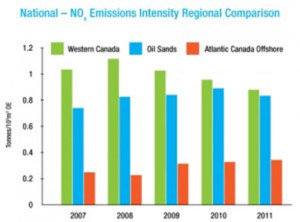
Atlantic Canada NOx intensity has increased since 2008, while Western Canada has seen a decrease in NOx intensity since 2008 and Oil Sands has been relatively flat since 2008. Source: Canadian Association of Petroleum Producers.
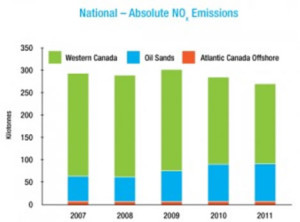
Total NOx emissions increased slightly in 2009 though show an overall decline from 2007 through 2011. Source: Canadian Association of Petroleum Producers.
Sulphur Dioxide
Sulphur dioxide (SO2) is emitted when natural gas or oil products are flared or when products sulphur is removed from crude oil and natural gas. Both SO2 and NOx may contribute to acid rain. Industry continues to improve the capture of SO2 resulting in less of it being emitted to air even as industry grows and production of oil and gas with higher sulphur content increases.
Nationally, SO2 emissions intensity has declined by 41 per cent since 2007.
Since 2007, absolute SO2 emissions have declined 35 per cent to 179,000 tonnes.
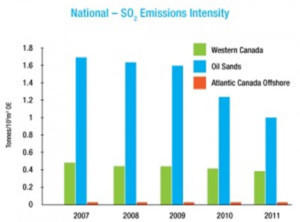
SO2 emission intensity continues to decline year over year. Source: Canadian Association of Petroleum Producers.
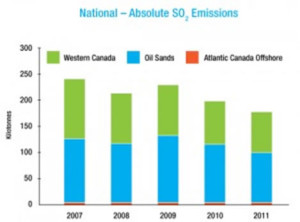
National SO2 emissions continue a downward trend. Source: Canadian Association of Petroleum Producers


